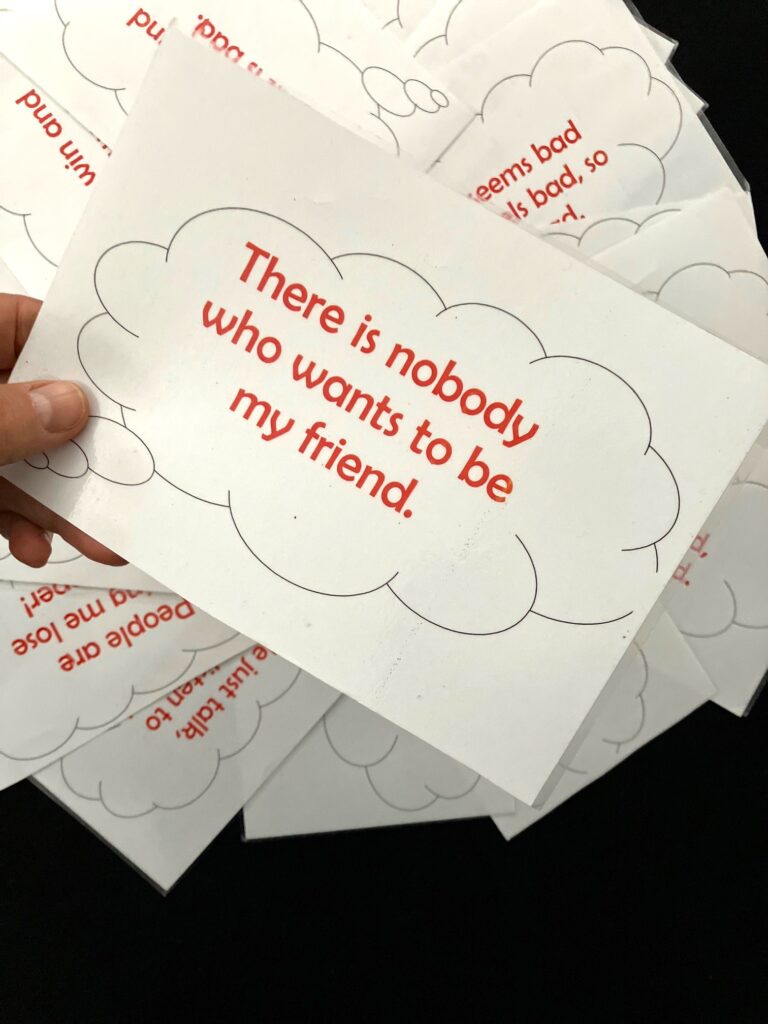Our aim in doing CBT with children should be to extract helpful and useful methods from CBT concepts. The children we see vary a great deal in age, intellect, temperament and predilections, so we should avoid getting locked into CBT treatment practices that are too rigid. As much as possible, we should allow our interventions to be shaped by the individual child we are treating.
Factors one should consider when selecting psychotherapy tools for children
There are so many different things to be considered when planning therapy interventions. Here are some factors I have thought of, along with examples of resources I have developed in an effort to accommodate different learning styles. Although I do quite frequently employ resources developed by others in the field, in this article I am primarily displaying resources I have developed myself, available for free download or in my books.
Attention span
Many children need frequent, positive prompting to stay focused. Some benefit from token prompts, like the ones shown below.

Preference to face towards therapist directly vs. indirectly
Many children, especially children with autism, have a limited capacity to look directly towards the therapist. It can really help to arrange for both you to direct gaze towards something in between both of you. The example shown below is a laptop with one of my CBT videos on the screen.
Levels of intellect, education, language comprehension and reading ability
It is easy for us to end up confusing our young clients with our language and concepts. There are some resources available that are simple, appealing and very helpful. An example, shown below, is a screen shot from one of the hundreds of Everyday Speech Videos.
Special interests
Many children, especially children with autism, are strongly motivated by therapy content that references their particular interests. For example, a child with an interest in Godzilla movies could be reinforced by an anger management activity that involves drawing Godzilla.
Ability to remain seated vs. need to stand and move around
In my own work years ago in a community-based summer teen program for kids with autism, we sometimes did CBT-based activities in small groups while standing. In one such activity, I spread CBT Thought Bubbles all over the floor and asked the participants to walk around and match up “Poison Thoughts” with corresponding “Antidote Thoughts.”
Receptivity to information and instruction coming from a computer screen
Many children are strongly conditioned to pay close attention to information presented on a computer screen. We therapists sometimes overvalue our spoken words. Most kids, and not just the ones with ASD, often consider information viewed on a screen as somehow more noteworthy that the same thing viewed in the “real world.”
For that reason, quite a few of the CBT activities on my website can be accessed in both printable and screen-based versions. One example is the Mint New Thoughts activity, in which “Old Thought” play money is torn up or shredded and then replaced with “New Thought” money. When I later made it available in an animated, screen-based version, most of my clients came to prefer it that way. See the example below – check out the short YouTube demo.
Preference / need for having something in their hands
Quite a few of the children I have seen in therapy, especially children on the autism spectrum, need to be holding something while they are talking with me. I have spent a lot of time creating things for them to hold which are related to our therapy work. An example, shown below, is one of three CBT-themed paper fortune tellers on my website.
Aversion to prolonged out-loud verbal interaction with the therapist
Many children, most notably ones with ASD, need to be offered productive alternatives to merely talking in therapy sessions. Many children highly value activities in session in which the therapist is saying relatively little while the child works on something meaningful. Below are two worksheets that go along with the Emotional Thermometer download from this website. These simple sheets can expedite an inquiry while affording the child a chance to not hear the therapist talk for a little while. Many children will in fact express things by writing, circling or drawing that they would be averse to saying aloud.
Preference for tangible product of the therapy session
Many children value doing and making things in therapy sessions more than talking about them. The image below shows a “board game” similar to ones I have made with children in therapy sessions. You create these in PowerPoint and after you play the game with the kid, you can print it out, or email it to the child’s home, if the child feels this would be helpful.

Need for family participation to generalize learning
Most of the kids we see in therapy will need to follow up at home with real-world practice. If children want or need parental involvement, then it helps if the tangible product of the session is something the child can actually help show and explain to the parents. Below is a mock-up of the sort of email one might send in these kinds of situations.
I wish you success with your own CBT interventions with children.
Joel Shaul
Click on links below to access other parts of this series on CBT refinements for children.
Intro: Refinements to Make CBT Better Suited for Kids [link]
Part 1: About CBT YouTube Videos & How to Use Them [link]
Part 2: CBT Token Systems – CBT Cards, a Free Download [link]
Part 3: More CBT Token Systems – Using Mr. Yuk Stickers [link]
Part 4: Creating Thought “Enemies” and “Heroes” in Child CBT [link]
Part 5: Tailoring CBT Methods & Media to the Individual [link]








